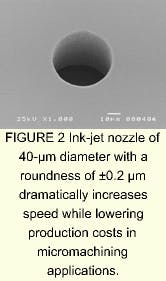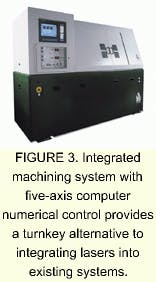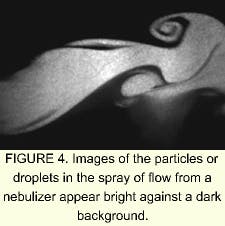New uses for copper lasers include high-speed imaging and fabrication of fiber Bragg gratings.
Andrew Kearsley
Higher powers, diffraction-limited beam quality, and new ultraviolet (UV) wavelengths are enabling copper lasers to address new markets and reduce costs. Kinetic enhancement has trebled visible powers to 100 W in a diffraction-limited beam for micromachining applications. And new frequency-doubling techniques generate high-power UV light ideal for producing fiber Bragg gratings (FBGs). Together with significantly improved reliability, these improvements are key to keeping ahead of increasingly demanding needs in industrial and scientific research.
Copper lasers operate simultaneously at two wavelengths510 nm (green) and 578 nm (yellow)and generate short pulses of 20-50 ns with good pulse-to-pulse stability at a high repetition rate. Commercial copper lasers provide output powers up to 120 W and repetition rates up to 50 kHz from single units. Even higher powers can be obtained from oscillator/amplifier chains. Latest-generation copper lasers are characterized by excellent beam quality, high reliability, and low operating costs. They are used in a wide variety of applications, the most significant being high-speed imaging and micromachining.
FIGURE 1. LM100-X, 35-W diffraction-limited KE laser provides a low-divergence output beam.
Higher average power, diffraction-limited beam quality, and improved UV performance are all features obtained by the kinetically enhanced (KE) copper lasers that have recently become commercially available. Researchers in Prof. Jim Piper's group at Macquarie University (Sydney, Australia) have helped to pioneer the blending of small, carefully controlled quantities of gas additives to the neon buffer gas of commercial copper lasers, which has brought about remarkable improvements to laser performance. The patented kinetic-enhancement process increases useful output powers by a factor of three, compared to copper lasers of the same dimensions, and allows the maximum repetition rate to be increased from 30 to 50 kHz, without any increase in overall footprint.
The KE copper lasers also produce low-divergence output beams very close to the diffraction-limited value of 50 µrad in a beam 25 mm in diameter, which is particularly suited for micromachining applications (see Fig. 1).
Reducing micromachining costs
Copper lasers have been used for several years for micromachiningparticularly for drilling high-quality holes for fuel injectors and industrial ink-jet printer heads. Until recently, most systems used a pair of lasers in an oscillator/amplifier configuration. With the introduction of the KE laser, single oscillators can now do the jobhalving the size and cost of the laser part of the system. In addition, the increased power of a KE oscillator/amplifier pair offers 100 W of nearly diffraction-limited light for drilling very-high-precision/shaped holes in thicker components such as turbine blades and combusters.
Recent work has demonstrated drilling of 40-µm-diameter ink-jet holes in stainless steel with an accuracy of ±0.2 µm. And because the laser process is 50 times faster than the electrical-discharge machining process it replaces, the cost of production plummets (see Fig. 2). This level of precision manufacturing also requires an ultrahigh-accuracy trepanning head. And full five-axis machining systems for industrial process development that are based around either conventional Nd:YAG or KE copper lasers have become commercially available as an alternative to the traditional practice of integrating lasers into existing industrial machining systems (see Fig. 3).
The capability of copper lasers stretches beyond the drilling of precision small holes in metals. Advanced alloys, ceramics, and diamondindeed all hard materialscan be machined just as efficiently. The machining techniques available include drilling, milling, cutting, etching, and high-resolution marking.
UV opens Bragg grating market
Copper lasers also are finding use in the fabrication of FBGs, which are principal components in fiberoptic links that allow several communication channels to share the same fiber by means of dense wavelength-division multiplexing. Gratings are written by exposing the fiber to intense UV light from a laser operating in the 230- to 260-nm range. By frequency-doubling a copper laser, we have developed a 255-nm source for FBG manufacture that is stable, long lived, reliable, and simple to operate.
FIGURE 2 Ink-jet nozzle of 40-?m diameter with a roundness of ?0.2 ?m dramatically increases speed while lowering production costs in micromachining applications.
Copper lasers are more efficient than frequency-doubled argon-ion lasers in this application and produce pulses of moderate peak power, placing less stress on the doubling crystal. Copper lasers also use less cooling water and electrical poweronly 4 kW to produce 600 mW of UV compared to 20 kW to produce 100 mW from argon lasers.
The 249-nm KrF excimer laser also offers advantages for FBG manufacture. But high-peak-power pulses damage fibers unless the beam is greatly attenuatedeliminating the apparent power advantage.
A frequency-quadrupled Nd:YAG laser emits at 266 nm. In the same spectral region, copper lasers give the choice of three conveniently spaced wavelengths from one laser. Frequency-doubling and sum-frequency generation produce output at 255, 271, and 289 nm. Powers in excess of 1 W are available commercially for a wide variety of applications including machining of polymers. Tests at Macquarie University have shown that powers up to 5 W can be obtained at 255 nm when doubling is combined with the kinetic-enhancement process. Commercial versions are expected soon.
High-speed imaging
A major application of copper lasers is high-speed imaging, exploiting the ability of the laser to produce high-power pulses at tens of kilohertz repetition rates, which can be precisely synchronized with high-speed motion-picture or video cameras. One key feature is the short duration (typically 30 ns) of the laser pulses, short enough to freeze the motion of even the fastest-moving objects. The higher power and repetition rate of the latest KE lasers significantly increases the usefulness of the copper laser in imaging applications.
Copper lasers have been in use for fluid-flow studies for more than a decade. However, one new application area is the analysis of drug and propellant velocities produced by metered-dose inhalers, dry-powder inhalers, nebulizers, and nasal inhalers. The ability to visualize the entire spray gives clear, immediate insight into the operation of such devices, without any need for data collection and interpretation, as required by the alternative point-wise measurement techniques. Typically, the laser beam is formed into a light sheet through the spray while the camera views perpendicular to the light sheet (see Fig. 4).
Particle image velocimetry (PIV) is a well-established tool for measuring fluid velocities over a whole plane simultaneously. Laser light is formed into a sheet and two images are captured in quick succession. Computer analysis of the difference between the images reveals the velocity field. Applying copper lasers to this technique (rather than conventional low-repetition-rate Nd:YAG lasers) has allowed sequences of PIV measurements to be recorded at intervals a thousand times shorter than previously possible. David Towers and colleagues at the Rover Engine Research Facility (Gaydon, England) have shown that this approach is essential for a full understanding of air flow within auto engines, which in turn leads to engine-design improvements.
A second new application area is the recording of subjects normally obscured by strong background light, such as plasma-spray processes or explosive impacts. In an imaging system using a copper laser to illuminate the subject of interest, a high-speed camera fitted with a special shutter views only the copper-laser light, thus removing any bright light emitted by the subject itself, thereby revealing details of events as they take place.
In this way, it is possible to see through flames or arcs, and the technique has been successfully applied to welding processes, plasma torches, pyrotechnic explosions, and the operation of high-current switchgear. A recent dramatic application involved the filming of destructive tests that formed the final safety evaluation of a new jet engine. The manufacturer needed to see through the explosion but only had one chance to see the end of the $10 million engine. The manufacturer was delighted when the film was viewed, because the casing held and the engine passed the test.
Copper lasers offer diffraction-limited performance in a range of output powers that cannot be matched by any other visible laser. As well as having many applications in high-speed imaging and velocimetry, copper lasers now form the basis for industrial micromachining systems suitable for 24-hour production processes. The addition of ultraviolet output challenges other UV lasers in an increasing number of applications.
ANDREW KEARSLEY is managing director at Oxford Lasers Ltd., Abingdon Science Park, Barton Lane, Abingdon, Oxfordshire, OX14 3YR, England; e-mail: [email protected].



